Shaving and Composting
. . . But My Garden is in Order
“Some men there are who never shave (if they are so absurd as ever to shave), except when they go abroad, and who do not take care to wear polished boots in the bosoms of their families. I like a man who shaves (next to one who doesn’t shave) to satisfy his own conscience, and not for display, and who dresses as neatly at home as he does anywhere. Such a man will be likely to put his garden in complete order before the snow comes, so that its last days shall not present a scene of melancholy ruin and decay.” So wrote Charles Dudley Warner in his wonderful little book (much more than a gardening book) My Summer in a Garden (1898). I gave up shaving a few months ago, but I am putting my garden in order for autumn.
The scene is quite pretty as I look out my upstairs bedroom window upon my garden — my vegetable garden — each morning. 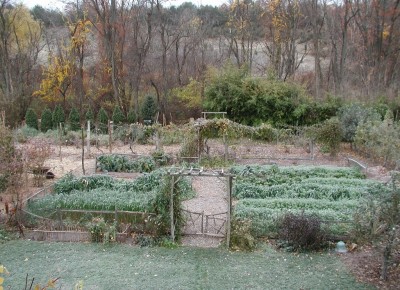 Weeds have been removed from the paths and the beds, and spent plants have been cleared away. What remains of crops is a bed with some tall stalks of kale that were planted back in spring. Yet another bed is home to various varieties of lettuce interplanted with endive, all of which went in as transplants after an early crop of green beans had been cleared and the bed was weeded, then covered with an inch depth of compost. Also still lush green is a bed previously home to edamame, which was subsequently weeded, composted, and then seeded with turnips and winter radishes back in August.
Weeds have been removed from the paths and the beds, and spent plants have been cleared away. What remains of crops is a bed with some tall stalks of kale that were planted back in spring. Yet another bed is home to various varieties of lettuce interplanted with endive, all of which went in as transplants after an early crop of green beans had been cleared and the bed was weeded, then covered with an inch depth of compost. Also still lush green is a bed previously home to edamame, which was subsequently weeded, composted, and then seeded with turnips and winter radishes back in August.
From my window, the remaining eight beds in the garden present mostly grasses in various states of lushness. The “grass” in this case is oats, sown in any bed no longer needed for vegetables at the end of this season. I had cleared such beds of spent plants and weeds, sprinkled oat seeds (whole “feed oats” from Agway), watered, and then, as with the other beds, covered them with an inch depth of compost. One bed was finished for the season except for six floppy cabbage plants. I staked those plants up tall and out of the way, and then gave the bed the same treatment around the cabbages’ ankles.
Ready for Spring
That’s it: It all looks fresh, green, and neat — but more than that, what I did is also good for next year’s garden. Cleaning up weeds this year makes for less self-seeding of annual weeds and seeding and establishment of perennial weeds. Cleaning up spent plants takes any pest-ridden plant parts off-site, reducing chances for future pest problems.
Dense growth of oats protects the soil surface from pounding rain so water percolates in rather than skittles off the surface, promoting erosion. 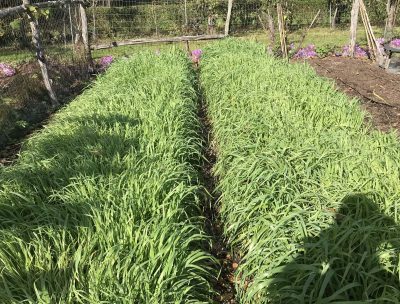 Below ground, oat roots pull up nutrients that rain and snow might otherwise leach away into the groundwater.
Below ground, oat roots pull up nutrients that rain and snow might otherwise leach away into the groundwater.
And finally, that inch depth of compost that each bed gets helps support the many beneficial fungi, bacteria, actinomycetes, and other soil microorganisms that make up the soil food web. In so doing, it will provide ALL the nutrition my vegetable plants, even intensively planted vegetables, need until this time next year.
Mr. Warner, I think, would approve. Even my non-shaving; I do trim my beard regularly.
Add Water, Conveniently
A lot of compost is needed to cover all those vegetable beds. For all the beds in my two vegetable gardens, as well as those in my greenhouse, I estimate my annual needs at almost 5 cubic yards per year.
My compost is made from hay I scythe from my small field, kitchen scraps, spent vegetable plants and weeds from my garden, some horse manure in wood shavings, and, for fun, old cotton or woolen clothing, and leather gloves and shoes.
Yes, I’ve read about striking a balance between feedstuffs high in carbon and those high in nitrogen in order to get a compost pile chugging along. As important is good aeration and moisture. Most compost piles that I see suffer from thirst.
A lot of water is required to wet the inner layers of a compost pile, and applying it requires more patience than I have. So I no longer do it manually.
I purchased a small sprinkler which I connected with 1/2” black plastic tubing (the same as I use for drip irrigation mainlines) along with some L connectors to lead the water line from the top center of a pile neatly down to ground level. Water pressure is variable from my well so I also put a pressure reducer, to 15 psi, in the line; a valve needing just one-time adjustment keeps the sprinkler wetting only the top of the pile. A U-shaped metal pin keeps the sprinkler firmly in place in the center of the pile.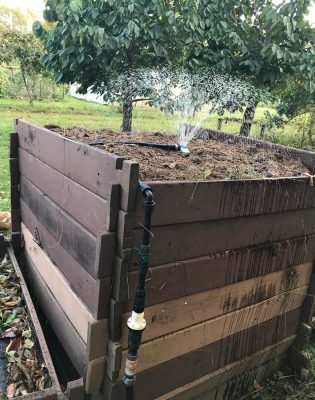
All that’s needed after adding a batch of material to the pile is to set up the sprinkler, turn on the spigot, and set a timer for about 20 minutes. The droplets cover the pile right to the edges and in a day or two temperatures soar to 140° or more.
Next year at this time, this year’s piles will be ready to do their part in putting my garden neat and in order.

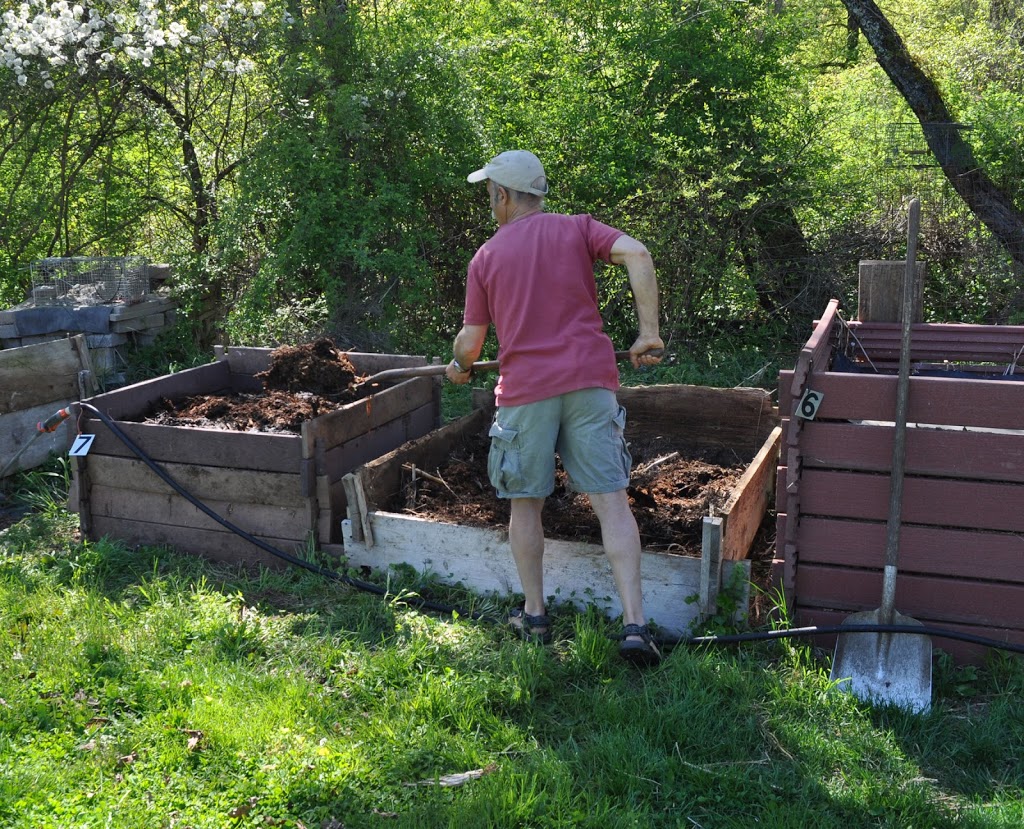
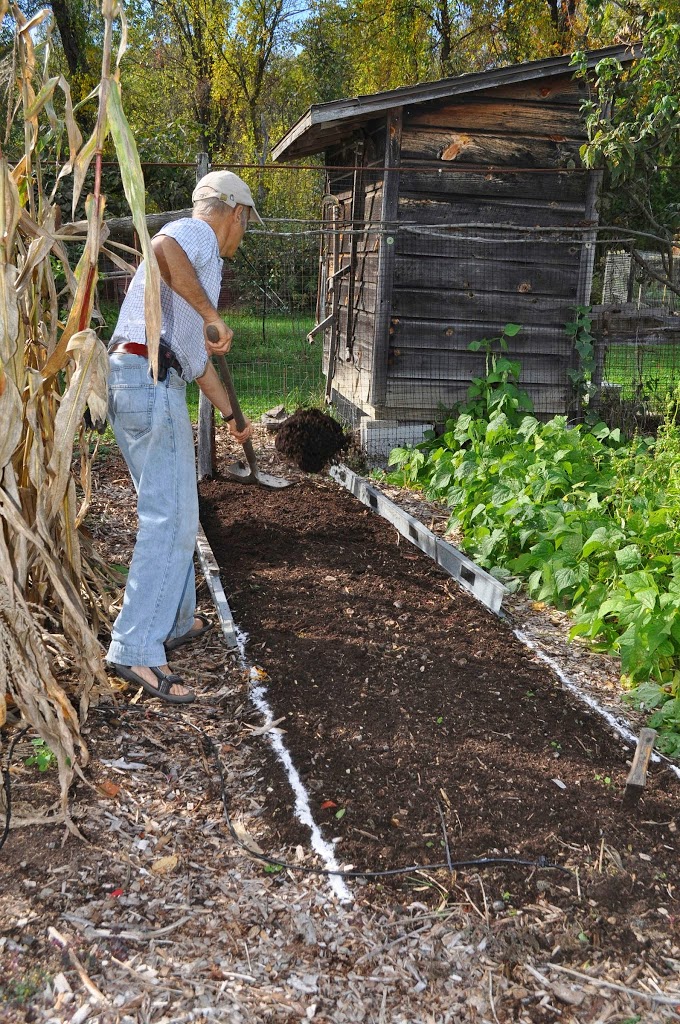


Lee, I read often but rarely comment, but I thought I would let you know I really appreciate your blog! Seeing the garden in order for winter is so satisfying, so thank you for sharing your process. My own garden is nearly there, but I’m waiting for more leaves to fall so I can shred them and mulch my garlic. My asparagus has yet to die back, so that will need to be done too. Still, satisfying. Happy autumn!
Where is a picture of the beard?
It would be shown only by popular demand.
This is the popular demand speaking: let’s see the show!
okay, okay.
Hi Lee, what do you do with the oats come spring? Do you dig them up and turn them over?
No need to dig them in. The oat grow until about January, then are killed by colder weather. The tops flop down, dead, and, come spring, I just rake them off. By the time I rake them, the tops and roots are hardly attached to each other. Undisturbed, the dead roots leave lots of small channels in the soil, add organic matter, and help its structure. I could leave the dead tops in place but that would delay soil warming in spring.
Thank you for sharing your experiences. I do a good amount of composting (for a 2 person family) as I have two piles going surrounded by 4 ft wooden pallets. I wonder, does adding some “septic” bacteria occasionally really help, or is it a waste of my money?
I am surprised not to see your hoop house; it is the pride and joy of my garden in the winter.
If anyone has not heard how easy arugula is to grow, they should try it. Save the seeds and you’ll have arugula for the rest of your life, even in January (in the hoop house).
It isn’t necessary, and is of no benefit, to add any special microorganisms to a compost pile. Or a septic tank, for that matter.
Great information and impressive winter preparations. I’m inspired, thanks.
I have a question: I’ve been putting rotted straw from my duck runs on my raised beds every fall in thick 6″ layers. Recently I read that straw bales are not chemical free, but contain herbicides from the crops being sprayed to keep weed seeds from the straw. Have you heard this? Would the herbicide be persistent in the straw bales? I’m concerned for my ducks and my vegetables. Since the vegetables grow well each year, the herbicides don’t seem to be active a year later, but it concerns me. Seems like so many organic gardening books recommend using straw for mulch! Thanks for any advice
Aminopyralid, clopyralid, fluroxypyr, picloram, and triclopyr are in a class of herbicides known as pyridine carboxylic acids. They are registered for application to pasture, grain crops, nonresidential lawns, certain vegetables and fruits, and roadsides. When it’s used, it can persist in animal manure, even compost made from the straw or manure. For more, see my post https://leereich.com/2014/12/its-all-organic-but-not-necessarily-all-good.html
Voting for the picture of the beard!
I so admire your garden. I know what work it takes to keep a garden looking like yours. You have taught me so much over the years! And I still enjoy your video on composting … how your daughter’s designer jeans composted in record time as compared to Levi’s LOL!
Okay, the beard will get visual coverage, sometime.
Lee – Great post as usual. Question about your compost container. Is it a commercially available product or did you make it yourself? It looks like TREX or a similar product.
I made the compost bins myself out of a number of different brands of “manufactured wood.” They were a pain in the butt to make but now will last for a very, very long time. After a number of years, I’m still very happy with them. I’d like to get them manufactured commercially but have made no headway in that direction.
Echo’s to Becky’s appreciation to your blog. I also use it as a Gardener’s Calendar, and to encourage a bit more discipline on my end to put my garden in order for the winter.
Lenny P.
I never would have thought that shaving and composting could be connected, but this post has opened my eyes to the many possibilities for eco-friendly hair removal! It’s inspiring to see how simple changes to our shaving routine, like using a safety razor or compostable razors, can make a big impact on reducing waste. Thanks for sharing this informative and thought-provoking piece.